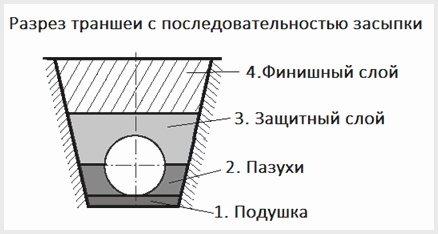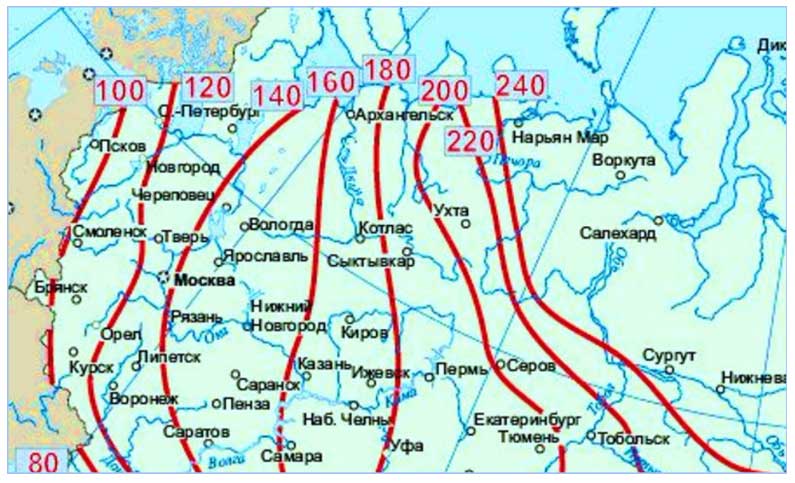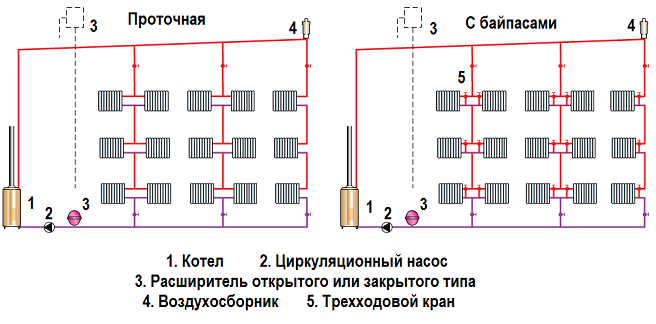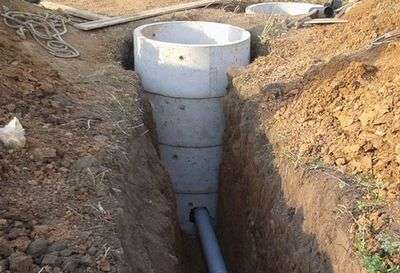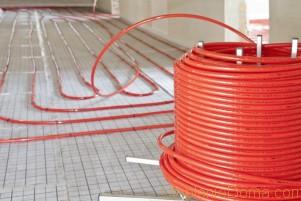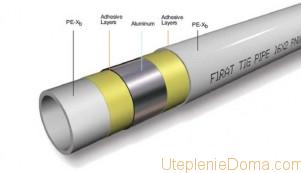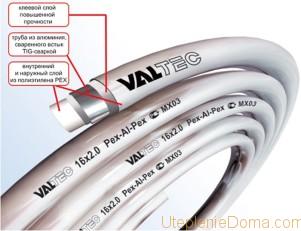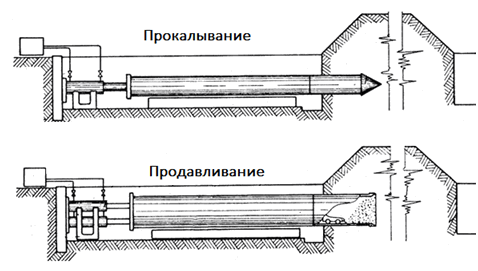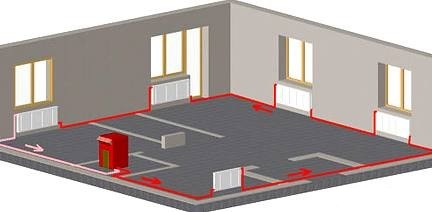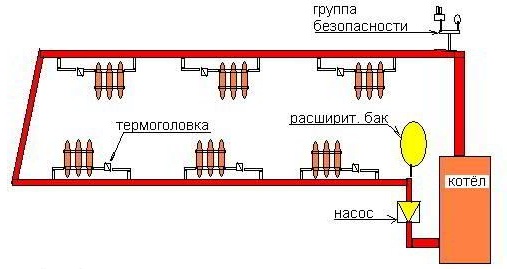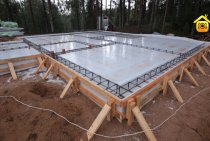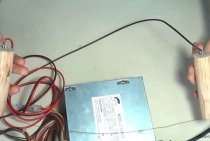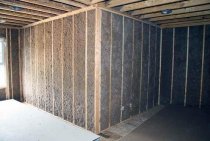Features of the choice of thermal insulation for pipes
Thermal insulation is used both for centralized heating mains and in-house heating networks in order to reduce heat losses. When choosing thermal insulation, it is necessary to take into account the diameter of the pipes, the temperature of the coolant and the operating conditions. The type of insulator to be used depends on the diameter of the pipes. These can be rigid molded cylinders, semi-cylinders, and soft mats in rolls.
Insulation of heating pipes of small diameter can be performed using cylinders, half-cylinders (equipped with grooves that create convenient and quick installation on pipes), also using segments made of polymer or mineral wool heat-insulating materials. They have very high thermal resistance. In addition, they have a low degree of water absorption, resistance to mechanical damage and a strict geometric size. Consider the scope of the most popular materials for thermal insulation.
Backfilling a ditch
Backfilling of the ditch is started after checking the heating system in operation - if the pressure test of the circuit reveals flaws in its tightness, they will need to be removed.
Backfilling a ditch is a serious stage of work, the accuracy of which determines the uniform distribution of loads and the durability of the pipeline section into the ground.
Backfilling of the ditch begins with the laying of soft plastic soil on both sides of the pipe (in the sinuses). This is done equally along the entire length of the pipeline, not allowing it to move along the sides. The soil laid on both sides is carefully compacted, after which the pipeline is backfilled from the same material with a protection layer of at least 15 cm along the entire length and width of the ditch in accordance with the requirements of SNiP. The compaction of this layer is carried out to a small extent - this is a necessary requirement for the formation of a strong protective arch of soil over the pipe, based mainly on the sinuses on both sides of the pipe.
After the compaction of the protection layer is completed, the ditch is completely covered with soil excavated during excavation, removing large stones from it. Backfilling must be done equally along the entire length of the ditch, not allowing the formation of pipe sections with a significant difference in the vertical load from the soil.
An equally growing load from the backfill will be accepted mainly by the protective soil vault above the pipe, and the final value of the compressive force for the pipe is not terrible - it is designed for it.
If the ditch is filled in separate sections, then the difference in the vertical load on the buried and open sections of the pipeline will lead to the appearance of rupture forces, which the pipe resists worse.
Underground heating installation
In some cases, it is required to lay heating pipes in the ground, for example, if the boiler room is somewhat remote from the heated room. Before laying heating pipes underground, two problems will have to be solved at once:
A layer of soil and everything that is on the surface presses on a pipe laid on the floor with earth. Therefore, in order to protect the system, sleeves are used. In this capacity, a pvc sewer pipe with a diameter of 110 mm is perfect.
Before laying heating pipes underground in a sleeve, they must be insulated, despite the fact that the system is laid below the freezing level of the soil. Heat loss is still significant. Mineral wool or foam covers are used for insulation. In addition, pipes are produced that have a layer of foam insulation and a protective plastic sheath. They are specially designed for laying underground.
When organizing individual water supply at home with water intake from a well or well, it is necessary to take measures for the normal operation of the water supply system in winter to prevent freezing of water in the pipe.Therefore, the question of how to insulate a water pipe in the ground with your own hands is relevant for all users of their own water supply line. In order to insulate a pressure water pipeline underground, it is necessary to calculate and select the most optimal version of the insulation and correctly install it in compliance with the technology.
Rice. 1 Map of soil freezing levels
Mineral wool
Insulating materials using mineral wool are very effective thermal insulators. They are used in a wide variety of conditions. Mineral wool heat insulators withstand temperatures up to 650°C without losing their heat-insulating and mechanical properties. At the same time, they do not lose their shape and have high chemical resistance to oil, solvent, acid, alkali. They are non-toxic, and thanks to a special impregnation, they have a very low degree of moisture absorption. (See also: Water floor heating)
Advice! Mineral wool is good for protecting heating network pipelines and pipelines with hot water supply in residential and public buildings, domestic premises, as well as pipelines whose surface is exposed to heat, such as chimneys.
Types of mineral wool
Stone wool - made from alloys of basalt rocks. She was mentioned above.
Installation of a chimney for a gas boiler
Installation of a chimney for a gas boiler begins with cutting an exhaust hole, the size of which depends on the diameter of the chimney pipe
Fiberglass
Glass wool has an average thickness of up to 3-4 microns and 1550-200 mm. Thermal insulation materials made of glass staple fiber have a low density and application temperature (up to 180°C). Such materials are recommended to be used for overhead pipelines, for example, heating networks. Therefore, fiberglass is used in a more limited area. High-quality fiberglass is characterized by high vibration resistance, biological and chemical resistance, as well as a long service life. (See also: Polypropylene pipes for heating)
Egor Guest
It is more convenient to use ready-made insulation. We found polyethylene foam for 13mm pipes (this is the norm for hot water supply).
Next, the finished pipe insulation was selected so that it was put on the first thermal insulation. There can be any number of such layers.
If there is an air gap between the first and second insulation, this is good.
It is important to glue the seams of the last layer of insulation with reinforced tape
It can be wrapped with roll insulation, but it is easier to wrap not with two layers of 5 mm, but with one layer of 1 cm.
The foil inside will not work. She needs a gap, in my opinion, 20mm. It can be oriented outward or simply wrap the last layer with foil tape (this is done when installing air conditioners).
Insulation of heating pipes is an obligatory stage of work in the process of installing the entire system. This is especially true for pipe sections located outside the residential area (for example, on the street) and most of all exposed to adverse weather conditions.
The insulating material serves as a protective layer that maintains a given temperature regime, prevents the formation of condensate and slows down the process of metal corrosion.
Timely insulation of heating pipes can significantly reduce the percentage of heat loss and protect pipes from deformation in conditions of sudden changes in weather conditions.
Heat loss on the way from the boiler to the radiators can vary between 5-15%. Accordingly, in order to achieve the optimal temperature in the house, the owners have to increase the power of the boiler several times and pay the costs out of their own pocket.
Insulated pipes for heating allow you to forget about this problem for a long time.
In this case, the coolant circulating through the pipes cools down much more slowly, does not change its temperature and does not crystallize at the lowest temperatures.
Vertical pipe laying
Schemes with a vertical arrangement of highways are very popular among residents of multi-storey cottages.
This is due to the peculiarities of the functioning of such schemes:
- The coolant is heated in the boiler and rises up the line. After that, it descends through all available risers to the radiators;
- From these radiators, the coolant returns back to the boiler, while, in the case of two lines, the movement back is already carried out along horizontally located elements.
I must say that the supply branch is located horizontally. The scheme got its name - vertical or top - for the simple reason that the coolant comes from above, which can be seen in the image below:
Consists of the following elements:
- Heating boiler;
- Circulation pump (as a rule, it is available, but may not be);
- Expansion tank of an open or closed type (if there is a pump, then a closed membrane tank is used, if there is no pump, that is, the circulation is natural, then the tank is used in an open type);
- Vertical and horizontal branches;
- Batteries;
- Shaped elements.
Principle of operation
The principle of operation of all vertical structures is quite simple. From the heating element, the coolant enters the expansion tank. The movement is on the riser.
The expansion vessel must be located at the highest point. Such a container serves to normalize and create pressure.
Further from the tank, a branch departs, which is called the supply, or in this case, adjustable. This line is suitable for each battery. Thus, from the expansion tank, the heated coolant enters the batteries through this line.
Here she gives her heat to the environment. At this time, denser cold water pushes the heated water out of the boiler. This creates the movement of the coolant. Thus, slightly cooled water from the batteries enters the return line, which leads directly back to the boiler.
Today, almost all such schemes are equipped with a circulation pump, which forces the water to move along the mains. This leads to faster heat transfer, and therefore increases the efficiency of the entire structure.
The big advantage of the upper arrangement of the branches is that such an arrangement allows them to heat multi-storey buildings.
In addition, no one forbids, as in the previous case, to put its own shut-off valve on each individual radiator. In this case, it is not necessary to embed separate lines, since the design already provides for the parallel supply of all batteries with coolant.
Burying pipes
The first method of deep pipe burial is the oldest and most proven, but it may not always provide the necessary level of protection. The bottom line is that the pipeline is laid just below the depth of soil freezing, which is due to the climatic features of a particular area. In the layer of earth below the freezing level, the temperature is almost constant.
At first glance, it may seem that with minimal cash costs, it is possible to protect pipes from the cold, but in reality, not everything is simple because it is not always possible to achieve the desired depth. There can be quite a few good reasons for this - from the significant labor intensity of the work to the characteristics of the soil.
In some cases, deepening even 1 meter can be problematic. If you need to go even deeper, then the complexity of the work will become an order of magnitude higher.
When choosing a method of insulation, do not forget about another important point. If the sewer breaks down, even if not because of the cold, its repair will be quite expensive, since to identify the defect, you will first have to dig out the pipe, and then bury it again
Heating pipes with an electric cable
Obviously, it is possible to insulate sewer pipes by burying them to a sufficient depth only in outdoor areas. However, there are other areas located both on the street and in rather poorly heated rooms. For such areas, you can use a special heating electric cable, laid along the most important nodes and connections. The result of the work performed will be permanent heating that protects the sewerage system regardless of the weather.
However, this method has a couple of disadvantages. First of all, the consumption of electricity increases, especially in the case of heating rather long pipelines. There is also a dependence on the operation of electrical networks. Of course, in the event of a power outage, the generator will start working, however, this also costs a lot of money.
Why isolate
When laying a pipe outside a building, it (and the fluid flowing inside) can be adversely affected by moisture and low temperatures. In addition, some materials (polymeric) deteriorate faster and lose their qualities when exposed to direct sunlight.
Also, the pipeline can be damaged from actions (intentional or unintentional of a person).
Pipes are preferably laid in the ground for the following reasons:
- To prevent the negative factors mentioned above.
- In order not to create a network of communications (which will take up space, interfere with passage / travel) on the surface.
When laying a line underground, the following hazards remain relevant:
- The possibility of freezing the liquid flowing inside.
- The possibility of corrosion of the pipe itself - from exposure to moisture.
The first factor is relevant in winter: the depth of soil freezing in most Russian regions reaches (and exceeds) 1 meter. That is, in order for the flowing medium not to freeze in frost, pipes should be laid in the ground deeper than this indicator.
This is often inconvenient: this complicates further maintenance of the line (if it is necessary to check or repair, you will have to dig a deep trench), and the cost and timing of excavation during laying increases.
On the danger of lack of insulation
Water supply and sewage pipes are laid in the ground - both municipal (going from and to apartment buildings), and for private houses and various industrial buildings. Insulation should be used in both cases - since water flows inside these lines.
Moreover, it freezes very quickly - in less than an hour, an ice plug forms inside.
Since the pipeline is laid in the ground, to eliminate it, you will have to dig a trench, look for a frozen place and warm it up. And all this - in the cold. Moreover, at the same time, sewerage or water supply will not work in the house (depending on which line “sits down”).
In addition to the troubles that the sewerage or water supply in the house will stop working, if an ice plug occurs, there is also the possibility that the pipe will burst. This happens because when it freezes, moisture expands, meaning ice will take up more space than water. As a result, the walls of the pipe may not withstand.
Eliminating this problem is an even more difficult and less pleasant task than steaming a frozen area. In winter, in frost, you will have to not only dig a trench (and not a small one, but along the entire line of the pipe - to find the damaged part) - but also repair the pipe itself. Often this can only be done by completely replacing the cracked segment.
Which pipes are suitable for underfloor heating
Polymer pipes for laying under the screed
Naturally, modern underfloor heating is mounted from plastic, but it can be different and has different characteristics. Laying heating pipes in a private house under a screed replaces traditional radiator systems. To select a material, you need to determine the selection criteria:
The laying of heating pipes in a private house under a screed is carried out only in whole segments, without connections. Based on this, it turns out that the material must bend and the direction of the coolant flow must change without the use of fittings. Products made of single-layer polypropylene and polyvinyl chloride do not fall under this characteristic;
heat resistance.
All polymer pipes for heating outdoor and hidden laying can withstand heating up to 95 degrees, moreover, the temperature of the coolant rarely exceeds 80 degrees. In a warm floor, water heats up to a maximum of 40 degrees;
For laying heating pipes in the floor screed, only reinforced products are used, they are also called metal-plastic. Although the reinforcement layer is not only metal. Each material has a certain thermal elongation. This coefficient indicates how much the contour lengthens when it is heated by one degree. The value is determined for a section of one meter. Reinforcement is needed in order to reduce this value;
After laying the heating pipes in the floor screed, there will be no access to them. In the event of a leak, the floor will have to be dismantled - this is a sawing and time-consuming process. Manufacturers of polymer pipes give a guarantee on their products for 50 years.
Reinforced polymer pipes consist of five layers:
- two layers of plastic (internal and external);
- reinforcement layer (located between polymers);
- two layers of glue.
Thermal linear expansion is the property of a material to increase in length when heated. The coefficient is indicated in mm/m. It shows how much the contour will increase when it is heated by one degree. The value of the coefficient shows the amount of elongation per meter.
PEX pipe reinforced with aluminum
Immediately it should be mentioned about the types of reinforcement. It could be:
- aluminum foil (AL), 0.2–0.25 mm thick. The layer can be solid or perforated. Perforation is the presence of holes, as in a colander;
- fiberglass fibers are thin fibers of plastic, steel, glass or basalt. In the marking are designated FG, GF, FB;
- ethylene vinyl alcohol is a chemical element that changes the composition of plastic. Marked with Evon.
Before laying heating pipes in a private house, care should be taken that they have a reinforcement layer with aluminum foil or ethylene vinyl alcohol. Since one of the requirements when choosing a material is the elasticity of the contour. Products reinforced with fiberglass cannot be bent; fittings and couplings are used to change the direction of the coolant flow, which is unacceptable in our case.
Let's look at the types of materials used for the production of metal-plastic pipes:
polypropylene. Such products are marked PRR / AL / PRR. Thermal linear expansion is 0.03 mm/m;
cross-linked polyethylene. It differs from conventional low and high density polyethylene in that it undergoes an additional manufacturing step called crosslinking. On it, the number of bonds between molecules increases, thereby the product is given the necessary characteristics. It is marked PEX/AL/PEX and has a coefficient of thermal linear elongation of 0.024 mm/m, which is less than that of propylene.
We will separately consider products made of cross-linked polyethylene reinforced with ethylene vinyl alcohol, since it is best to lay such heating pipes in the floor. They are labeled PEX / Evon / PEX. This method of reinforcement allows you to kill two birds with one stone. Firstly, it reduces the linear expansion of the material to 0.021 mm / m, and secondly, it creates a protective layer that reduces the air permeability of the pipe walls. This figure is 900 mg per 1 m 2 per day.
The fact is that the presence of air in the system not only leads to cavitation processes (the appearance of noise, water hammer), but also provokes the development of aerobic bacteria.These are microorganisms that cannot exist without air. Their waste products settle on the inner walls, and the so-called silting occurs, while the inner diameter of the pipe decreases. For polypropylene pipes with aluminum foil reinforcement, the air permeability of the walls is zero.
Factors affecting heating pipes in the ground
A heating pipe buried in the soil is subject to the same influences as an outdoor pipe, plus factors due to the deepening:
- internal pressure of the heat carrier, causing ring and elongated tensile stresses in the pipe section;
- the temperature of the heat carrier is a factor, in addition to thermal influence, also causing stresses in the pipeline;
- soil temperature - in winter, taking into account this moment is very important;
- soil deformations - the pipe is affected by any of its displacements (settlement, shear, etc.);
- pipeline pre-bending stress - the ditch profile often repeats the local relief;
- vertical load - the effect of the weight of the backfill layer of the ditch;
- repulsive effect of soil on the walls and the bottom of the pipeline - resistance to vertical load;
- vibration loads - from passing vehicles, earthworks in the neighborhood, etc.;
- moisture - precipitation and groundwater;
- the influence of chemistry substances - compounds in the composition of the soil and the heat carrier;
- biological factor - bacteria, decomposition.
Similarly, the laying of the pipeline in the soil should be carried out taking into account all the above factors and solving the problem of how to warm up the heating pipes in the ground.
Trenchless pipeline laying methods
There are technologies for laying a pipeline in the ground without trenching.
These methods are intended to:
- reduce the volume of earthworks - a gain in time and costs;
- minimize damage to infrastructure - less cost for the restoration of decorative and road surfaces, unforeseen damage to highways;
- lay pipes in a straight line, avoiding obstacles of a small degree of complexity;
- minimize the damage from earthworks to the environment.
To date, the following trenchless methods are used in industry:
- rehabilitation;
- piercing.
Sanation
- this is the replacement of old pipes with new ones, which, in turn, is carried out in two ways: by relining and by the renovation method.
Relining
is based on pulling a new polymer pipe of smaller diameter inside the working pipeline while maintaining the old one as a protective shell.
renovation
- installation of a new pipe to replace the worn one with the destruction of the old one, the fragments of which will also protect the new pipeline from external damage.
Punching (punching)
- this is the connection of two pits dug to the required depth by a puncture made at a certain height of the wall.
Of the listed methods in everyday life, only the relining method can be performed. A cable is inserted into one end of the old pipe and pushed through until it exits the other end. Then a new whip is attached to the cable and pulled back. The applicability of this method depends on a number of factors:
- condition of the lumen of the old pipeline;
- diameter of the new pipe;
- the flexibility of the new whip;
- the length of the repaired area;
- the ratio of the diameters of the old and new pipeline.
With a favorable combination of these factors, the technical execution of the installation of a new pipe is not difficult. However, all this applies to pulling a new line without thermal insulation, and the condition of the old pipe insulation is unlikely to be satisfactory. Since it is not possible to insulate heating pipes inside the old line, the method loses its attractiveness in relation to heating.
Therefore, when installing heating pipelines with deepening into the ground in private housing, digging a trench or, at least, alternative laying of a pipe on the ground with backfill, is indispensable.
Today, according to their design, all heating systems can be divided into a lot of types and types - the classification is very diverse and has many parameters. Among others, the type of wiring is also distinguished.
The wiring can be horizontal or vertical. Depending on the type of installation chosen, the composition of the heating circuit may vary, but more about everything below.
Schemes with bottom wiring
As already mentioned, pipe laying can be done in two ways - vertically or horizontally. In the first case, such a wiring is called the top, and in the second - the bottom. Both that, and another can be used for the device. Restrictions are only on multi-storey buildings. Often the heating system of the second floor consists only of a warm floor.
So, all heating systems of a private house with a lower wiring can be of two types:
- Single-pipe, that is, contain only a supply pipeline, which is also a return pipeline;
- Two-pipe - with separate supply and return lines.
Single pipe systems
All single-pipe heating schemes for a private house can have not only a lower laying, but also an upper one.
The bottom gasket for a private house is shown in the photo below:
As you can see, the laying of all pipes is horizontal, except for one. This pipe is called a riser. It is connected to an expansion tank.
Such a system has all the disadvantages that are inherent in all single-pipe schemes without exception. We are talking, first of all, about the uneven heating of rooms located at different distances from the heating element.
Partially, this problem is solved by the lower wiring with bypasses, that is, additional lines. This design can be seen in the image below:
As you can see, each of the radiators has its own line of pipes, that is, a parallel line. This allows you to put a shut-off valve on each of the heating elements, so that, if necessary, you can restrict the access of the coolant to this radiator, but at the same time not limit all subsequent radiators in this.
If we consider the general positive qualities of all single-pipe heating systems in a private house with a lower wiring, then we can note the simplicity of their implementation, as well as the relatively low cost of the entire project.
